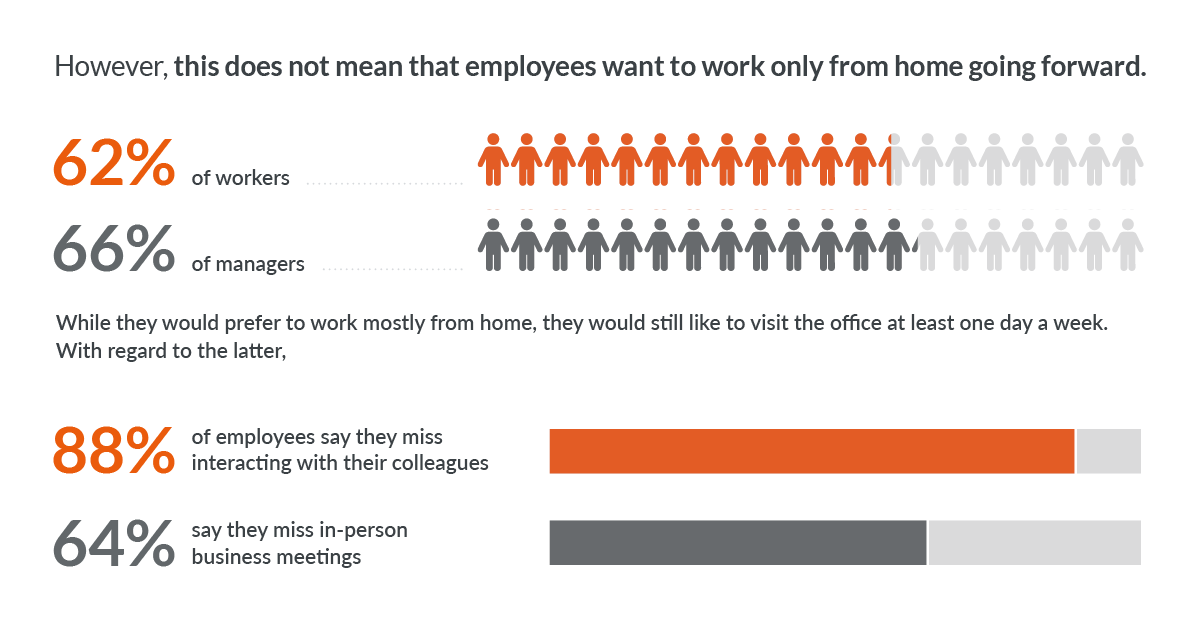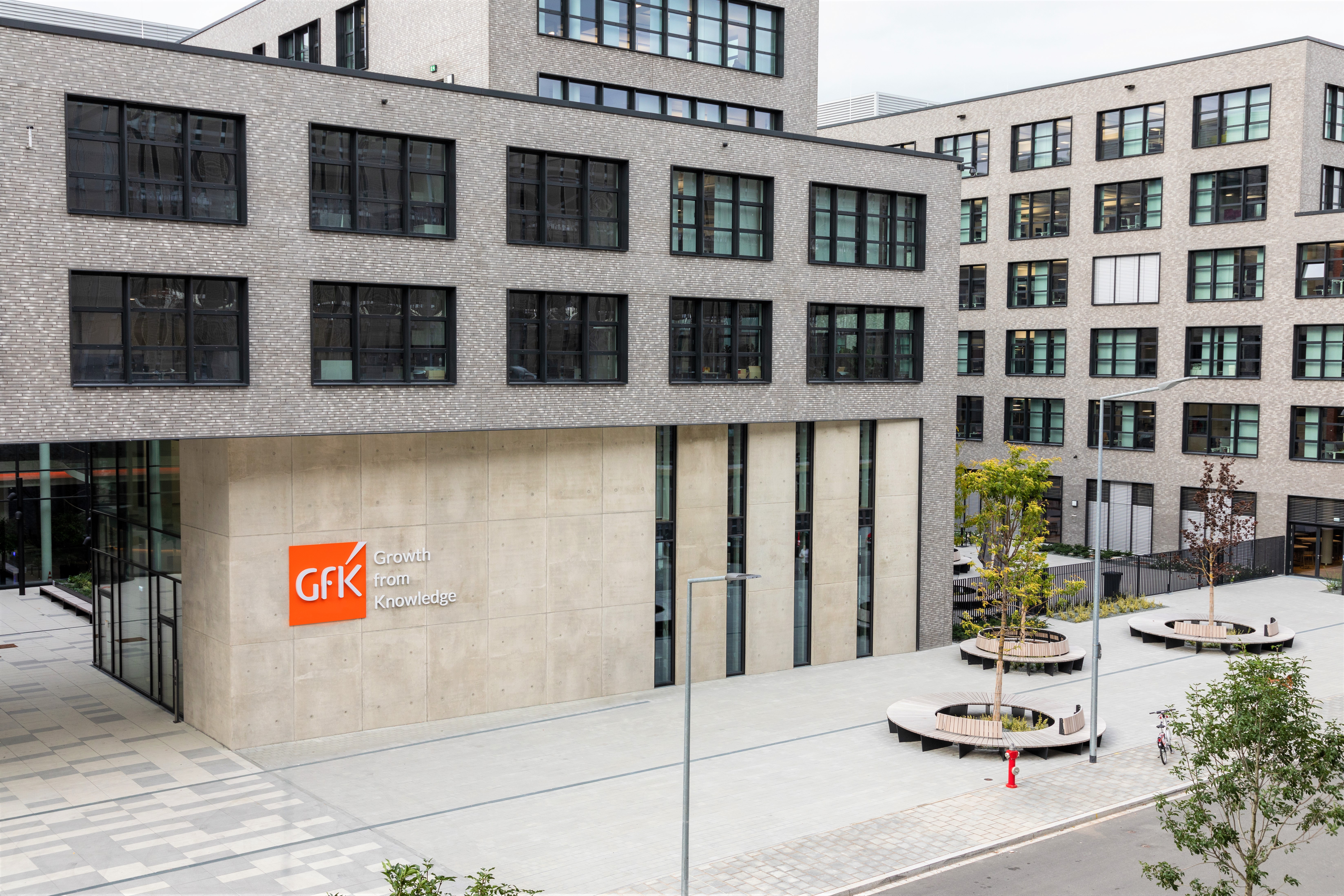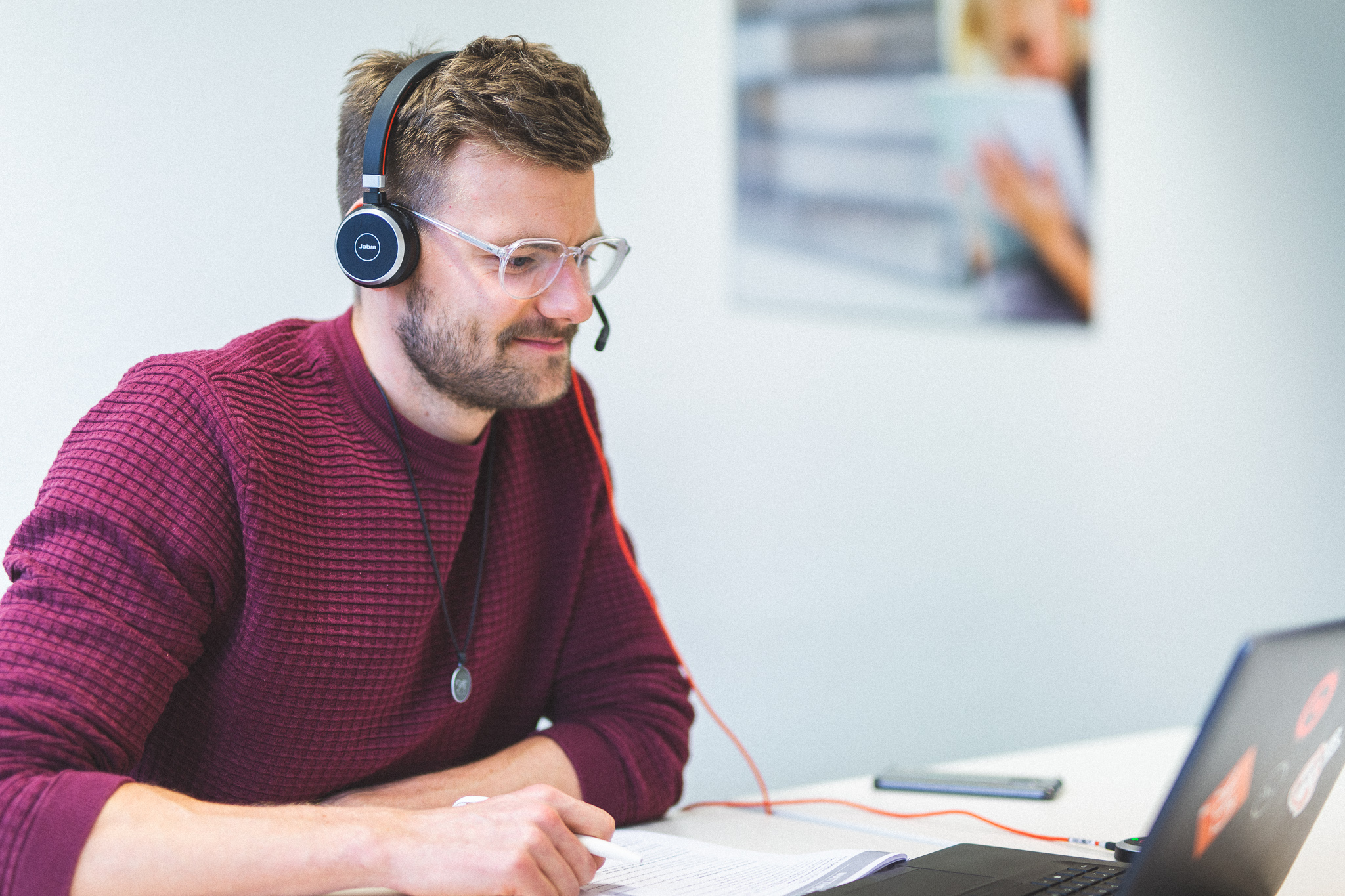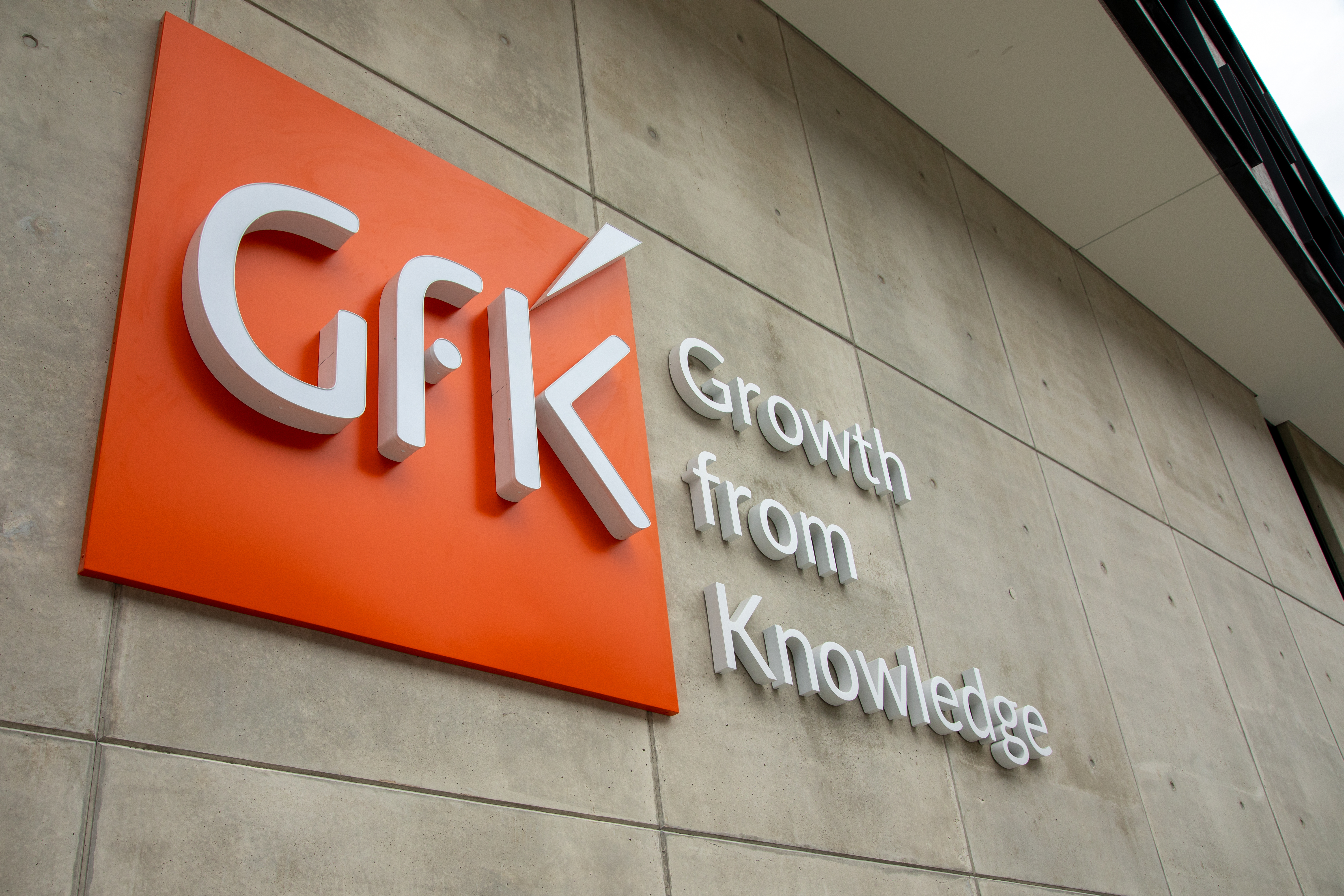Along with consumer changes when COVID-19 hit, most of our 8,500+ employees pivoted to working from home (WFH) – and many of us continue to do so even today. Interacting with clients, interviewing job applicants, hosting events, and socializing have largely gone virtual. WFH became the starting point to shaping the future of work at GfK.
Looking toward the future of work after the pandemic recedes, it is expected that the WFH trend is here to stay. Employees have embraced the better work-life balance resulting from WFH. EY’s 2021 Work Reimagined Employee Survey shows that 54% of employees would consider leaving their job post-pandemic if they are not offered some sort of flexible working arrangement. Mirroring this, employers are benefiting in terms of talent recruitment and retention, as well as the reduced need for office space, while not suffering the loss of productivity that was expected of WFH prior to the pandemic. As a result, 48% of employers say they are planning to introduce or expand the use of flexible work in the future.
We at GfK have put together a creative, forward-looking plan called Flexible Work@GfK to realize these opportunities. This transformation project will fundamentally redefine where and how our employees work moving forward.
The big idea behind “Flexible Work@GfK”
Flexible Work@GfK is rooted in the changing needs and expectations of our workforce in a post-pandemic world. We recognize our employees’ desire for greater flexibility in the workplace; to this end, we conducted surveys and workshops with our employees and consulted local teams to form the basis of the global framework that became Flexible Work@GfK. After all, as a trusted data and analytics business, who better to offer us constructive feedback than our own employees?

“From the beginning, we didn’t want this to be solely a top-down executive decision. Instead, we wanted to hear what people across the business feel about their experience working from home – what has gone well and what they will need to work successfully going forward,” says Jutta Suchanek, Chief HR & Diversity Officer at GfK.
The survey results confirmed our hypothesis – that our staff wants more flexibility in how and where they work. 70% say that WFH gives them a higher quality of life, 50% say that their stress levels have decreased, and 88% are happy with the time saved not commuting.

However, this does not mean that employees want to work only from home going forward. 62% of workers and 66% of managers say that while they would prefer to work mostly from home, they would still like to visit the office at least one day a week. With regard to the latter, 89% of employees say they miss interacting with their colleagues, while 64% say they miss in-person business meetings.

“What’s necessary is face-to-face meetings with clients. We need to really see how they react to a new product or platform, which is difficult to manage on a Teams call,” says Gernot Teufel, a Global Director for gfknewron, a new data analytics platform that delivers the latest market intelligence and recommendations.
After digesting the employee feedback, our executive team came together during an off-site meeting to discuss the next steps. At this off-site, we defined our core principles – essentially, the need to offer employees significantly more flexibility with regard to their work location in the future, but to also retain our offices, which we believe play a valuable role in promoting collaboration and strengthening company culture. We also noted that we need to strike the right balance – and that this balance could differ across teams and functions, so adjustments over time will be required.
Flexible Work@GfK takes shape
Following the off-site meeting, we started a dialogue with local office managers and work councils to discuss the future of work and to establish a concrete global framework based on our core principles. The result was Flexible Work@GfK, which is organized around two key concepts: Flex Days and Team Office Days. Flex Days guarantee that in a typical week, every employee will have two or three days on which they can decide whether to work from home or in the office. Flex Days alone are necessary but not sufficient because in-person collaboration would be 100% left to chance if all days were Flex Days.
The remaining days each week are Team Office Days, in which employees are required to come into the office to interact and collaborate with colleagues in their direct team and related teams. The Team Office Days per function or business area are spread evenly throughout the week to ensure that the office is well utilized but never overly full.
We unrolled the framework over the course of two months, briefing local leaders in our 70+ offices around the globe about the new flexible working guidelines. We acknowledged that the exact plan for implementing flexible work would vary by country, job function, office, and team; as such, we empowered these leaders to lead the change management process, with support from a global cross-functional team. Happily, these leaders have really embraced the transformation and have already proposed well-thought-out plans to implement a flexible work environment in their respective countries.
What this means for our offices

This new way of working has drastically changed how we see the future of work and how we utilize our office spaces around the globe. With a large proportion of our workforce working from home at any given time in the future, we are in the process of reducing our office real estate by 30%, which will generate millions of Euros in savings for investment in innovation and growth. Of course, this would not work if we retained dedicated desks and offices for individual employees. Therefore, we have taken, what at first glance seems like a radical step, but at second glance is the only logical thing to do.
Moving forward, there will be no individual cubicles or assigned desks in any of our offices around the world. This applies to all levels of the company hierarchy, from new joiners to middle management to senior management. By embracing 100% desk-sharing, we will be able to reduce our ratio of desks to people from 1:1 to an average of six desks for every 10 employees in the future.
We are also creating more open-plan spaces within our offices to foster teaming and collaboration among employees while also ensuring that our offices have separate collaboration spaces for meetings, workshops, and longer phone and video calls. However, we also know that there is a need to harmonize working patterns across teams to prevent desk shortages. To this end, we have procured an app that employees can use to reserve their desks in advance.

In addition, the future of work requires a flexible working model with the necessary tech infrastructure. Fortunately, 95% of our employees already had laptops when the pandemic hit, enabling us to pivot to home working overnight with 100% business continuity. “The IT department did a really good job. From day one, everything was working properly,” says Gernot Teufel. What’s more, 96% of our employees say they are satisfied or very satisfied with existing digital collaboration tools such as Microsoft Teams.
Supporting employees and managers
The future of work requires employers to consider the ways their work environment impacts mental health. Some thrive in a home working environment: research from Mental Health America indicates that WFH enables employees to reduce distractions during the workday, avoid office politics, and devote more time to health and wellness. “It’s been a novelty to WFH full time, and I’ve been trying to have fun with it. I’ve managed to explore my local area at lunchtime, go out for walks, enjoy home-cooked lunches, and more,” says Toni-Marie Jarvis, a Senior Project Manager at GfK.
On the other hand, 19% of employees – especially those with children – say they struggle to balance work with their personal lives. “WFH was hard as I had three young kids running around the house. I had to get up at 7 am, get four hours of work done, take care of the kids, and then go back to work again thereafter,” says Vlad Ardelean, a Senior Data Scientist at GfK.
At GfK, we strive to support our employees’ mental health wherever possible. “In addition to flexible working solutions, we have partnered with Spectrum. Life to provide every employee with access to hundreds of qualified health and wellbeing experts. This ensures that our employees receive all the mental health support they need – both during the pandemic and beyond,” says William Otero, Employer Branding Manager at GfK. What’s more, we regularly share tips on managing virtual work and train managers on how to integrate new employees remotely.
At GfK, we are also concerned with work safety, even if the work is taking place at home. To this end, we are ensuring our employees are furnished with the proper equipment they need at home, including monitors, keyboards, and ergonomic chairs.

Lessons learned and looking ahead at the future of work
Overall, the employee response at GfK to Flexible Work@GfK has been highly positive. “To have the flexibility to work from home when you like, but to also have the option to go to the office when you want to, is amazing,” says Anna Trautmann, a market research consultant at GfK.
We have also observed that the desire for greater work flexibility is universal, transcending functions, cultures, and countries. The globally mandatory policy to provide workers with two to three Flex Days per week is feasible and desired, for example, from Karachi in Pakistan to Nuremberg in Germany – for both our Finance teams and our Commercial teams.
Higher employee satisfaction is not only a desirable end in itself, but it also has direct implications for business success and the future of work. Fundamentally, our business is about our people, and a flexible environment is one piece of the overall package that makes GfK a great place to work. If we can retain, develop and attract the right people, this will, in turn, improve our ability to serve our clients and grow our business.
Of course, Flexible Work@GfK is still very much a work in progress, especially given the evolving COVID-19 situation. “Implementing Flexible Work@GfK will be a multi-year project starting now, and then gaining momentum after the COVID-19 crisis,” says Jutta Suchanek. “I’m sure we’ll gather more learnings in the next couple of months, and this will help us see what’s working now and what we need to adjust.”

All in all, we are excited about what the future of work at GfK holds. With Flexible Work@GfK, we look forward to a true win-win-win: for our employees, managers, and for the company overall.
Help us shape the future of work
FAQ section
What will the future of work look like?
The future of work will likely be a hybrid of office working and remote working. The COVID-19 pandemic and ongoing digitization have shown that most professionals can carry out their jobs from home; at the same time, the office will continue to play a vital role when it comes to collaboration and team-building.
What are the benefits of remote working?
The advantages of remote working are numerous. For instance, the elimination of the daily commute saves time, translating to better work-life balance for many employees. In addition, our data shows that employees feel more productive when working from home. WFH also has a net positive effect on energy consumption.
How should employers embrace change in the workplace?
Employers should strive to offer their staff flexible working solutions to increase satisfaction and retain talent. Any new transformation project should take into account employees’ individual circumstances and how these affect where and when they work.




